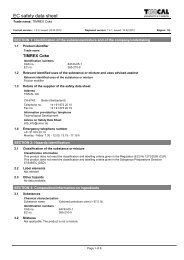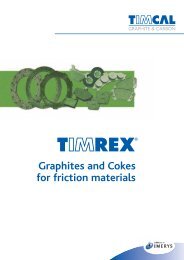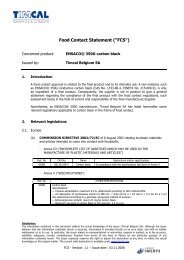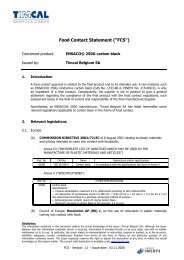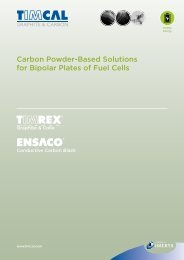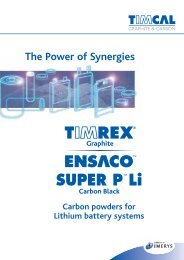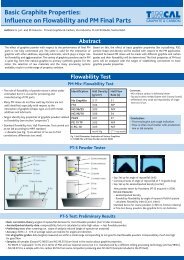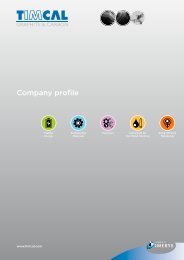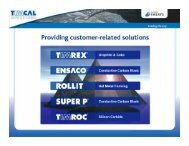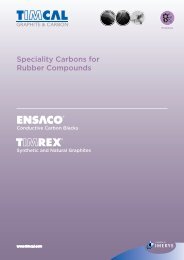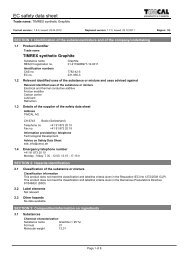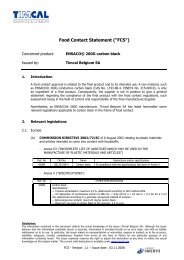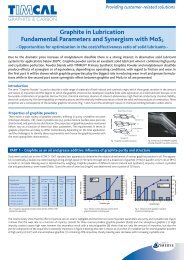Brochure: A Synopsis of Analytical Procedures - Timcal
Brochure: A Synopsis of Analytical Procedures - Timcal
Brochure: A Synopsis of Analytical Procedures - Timcal
You also want an ePaper? Increase the reach of your titles
YUMPU automatically turns print PDFs into web optimized ePapers that Google loves.
<strong>Analytical</strong> proceduresfor TIMREX ® and ROLLIT ®DispersionsFriction measurementwith Tribo-MeterThe friction is measured between twosteel specimens chosen to represent thepierced shell (the upper specimen) and themandrel (the lower specimen) during therolling <strong>of</strong> seamless tubes. The test is automatedand consists <strong>of</strong> several steps. The firststep consists <strong>of</strong> coating the lower specimenwith the lubricant. The upper specimen isheated in-situ to 1050 °C and positioned automaticallyover the lubricated piece that holds atemperature <strong>of</strong> 100 °C.The upper specimen (the shell) is thereafterreleased and a load is applied hydraulicallywhile the lower specimen (the mandrel)is being pushed forward with a motor.The friction force is measured during thedisplacement. A computer calculates the frictioncoefficient and energy dissipated duringthe sliding. The test variables are the slidingspeed, the load and the temperatures.Reference:- TIMCAL methodSolid contentnThe solid content is measured using aHalogen Moisture Determination thermobalance.nIn this procedure 1 to 2 g <strong>of</strong> the dispersionare placed on the sample holder and driedat 120 °C until a constant weight isachieved.nThe remaining weight is recorded andexpressed as a percentage.Reference:- TIMCAL methodViscosity and flow behaviourViscosity is measured in the steady state asa function <strong>of</strong> the shear rate as well as in oscillatingmode as a function <strong>of</strong> the amplitudewith a constant frequency. Thixotropicbehaviour is measured by observing the viscosityin an oscillating test as a function <strong>of</strong> thetime. A rotational rheometer with a coneplatesetup is used and the measurements areperformed at room temperature.1-2 grams <strong>of</strong> liquid sample are put in thegap between a stationary plane and a rotatingcone. A laminar flow <strong>of</strong> layers is created. Theviscosity is obtained from measuring theinternal resistance and a flow curve isobtained.Reference:- TIMCAL methodWetting testIn the wetting test the quantity <strong>of</strong>remaining graphite on steel surfaces ismeasured after being sprayed with dispersions.The test has been developed to simulatethe behaviour <strong>of</strong> the dispersion whensprayed as a lubricant on a hot mandrel inthe seamless tube production.Steel plates are being weighed and heatedto the desired temperature in an oven andthereafter put on a sliding support. The dispersionis sprayed with a typical pressure <strong>of</strong>50 bar on the steel plates passing under thespraying unit with a speed <strong>of</strong> 1.5 m/s. Thesteel plates are dried and weighed to obtainthe deposited graphite quantity as well as itsthickness.Reference:- TIMCAL methodpHThe pH is measured using a Digital pHMeter with a calibrated pH electrode.The clean electrode is immersed into theliquid. After stabilization <strong>of</strong> the reading thepH is recorded.Reference:- TIMCAL method



